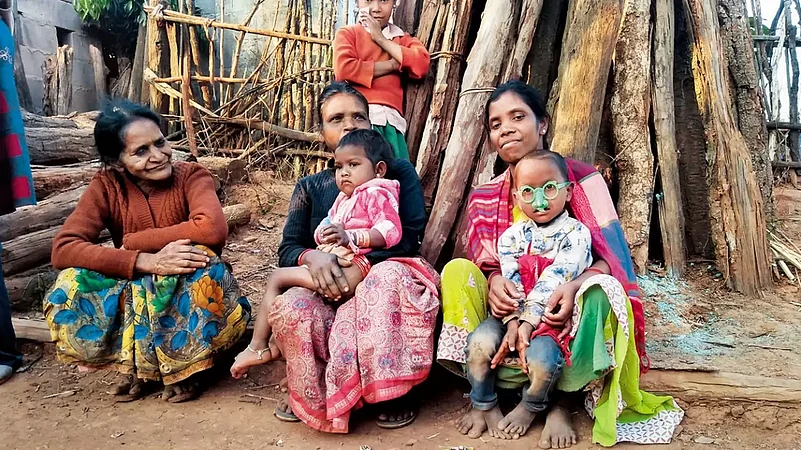Sita Asur, a 50-year-old resident of Sakhua Path, hesitatingly talked about the hardships the local undergo. They have no drinking water, hardly anyone has benefited from the government housing scheme and healthcare constitutes the biggest challenge for the Path residents. Says Sita, whose name has been changed for security reasons, “For any disease, the patient has to be carried 50–60 km away to Bishunpur block. Sometimes, they die on the way. Often, after reaching Bishunpur, one is referred to Gumla (district headquarter), and from there to Ranchi.” Last year, for instance, Rakesh Asur was bitten by a snake and died on his way to hospital.
Around 200 km away from Ranchi, the Asur Adivasis living on top of the remote mountains across the villages, such as Sakhuapani, Jobhi Path and Polpol Path, had lost their traditional occupation of iron smelting years ago. Now, the lives of over a 1,000 Asur families living in these villages, called Paths, have been ruined by bauxite mining.
Detailing the perils of mining operations, 40-year-old Vimal Chandra Asur, who is the president of the Adim Janjati Yuva Sangh Jagrit Abhiyan, an Asur tribe movement, and is a resident of Polpol Path, next to Sakhuapani, says, “The companies are mining and carrying away the bauxite from here, but the local villagers are not getting any benefits. There is a large amount of dust being emitted into the air, causing tuberculosis among many people, apart from other diseases. There are no health centres around, forcing us to travel 60 km over even minor illnesses.”
Dadu Asur, 70, lives in the same village and has a chest ailment dating back three decades. The villagers and Dadu’s son Tipun say that the wound has turned into cancer due to poverty and lack of treatment.
According to a study titled “Bauxite Mining and Adivasis” (2016–17), carried out by Jerome Gerald Kujur and Rakesh Roshan Kiro, the lives of Adivasis from these Paths, spread over Latehar and Gumla districts, have been severely affected by mining. Going unabated since 1983–84, mining activities have adversely affected the areas in many ways, including natural water sources, air, education, agriculture and employment. The one-year study documented the death of four Adivasis due to tuberculosis, while more than half a dozen were reported stricken by paralysis.

Out of the 32 scheduled tribes of Jharkhand, eight are categorised as Particularly Vulnerable Tribal Groups (PVTGs), earlier known as primitive tribes. As per the 2011 Census, state’s population of just under 3.3 crore included 86.35 lakh Adivasis, out of which the PVTGs numbered 2,92,359. The population of the Asur community stood at just 22,459.
Vandana Tete, general secretary of the Jharkhand Bhasha Sahitya Sanskriti Akhra and coordinator of the Asur Radio initiative, holds mining responsible for the deaths caused by debilitating ailments such as TB and cancer. According to her, young girls are also developing diabetes and respiratory diseases. “The Asurs’ lives have gone from bad to worse due to mining,” she says.
First, their generations-old occupation of iron smelting was snatched away by companies and when they started farming, their lands were taken away for mining, she rues, with no compensation. There are no schools and no hospitals in the mining area. “They have done nothing. The dust is making people fall sick, and by the time the ailment is discovered, it is too late,” she adds.
The entire landscape is pockmarked by massive quarries caused by mining, as one travels through the mud roads in the Path area, while a film of toxic dust envelops everything. There is no primary health centre around for miles and deaths are common due to the lack of treatment. The only “facility” that the Asurs get from the government is 35 kg of monthly ration under the Dakiya (postman) scheme.
Around 6 per cent of India’s bauxite production comes from Jharkhand, mostly mined in the Gumla, Latehar and Lohardaga districts, which are tribal dominated and covered under the Fifth Schedule of the constitution. The Path region and other villages affected by bauxite mining fall under the Gumla and Latehar districts. As per the Indian Mineral Yearbook 2020, within the three years between 2016 and 2019, as much as 72,95,956 tonnes of bauxite, worth about Rs. 611 crore, was mined from the area.
Other major mining districts of Jharkhand have also suffered a similar fate and the worst affected communities are invariably Adivasis. Human rights activist and author Gladson Dungdung notes in his book Vikas ke Kabragah (The Graveyards of Development) that around 6 crore people were displaced in India under different projects in the first six decades since Independence and 2.4 crore of these were Adivasis. In Jharkhand, 15,03,017 people were displaced between 1951 and 1995, with 80–90 per cent coming from among Adivasis and indigenous communities.

Dungdung says, “The largest amount of displacement in the name of mining has been faced by the Adivasis and it continues. Be it state-run mining or private corporations, it is the Adivasis who bear the brunt.” According to him, private mining began with the forests of Saranda in 1923, when the Tatas acquired the tribal land to source iron ore. But the three villages displaced by the Tatas have not been rehabilitated even today.
Jharkhand has 40 per cent of India’s mineral reserves. It holds the first, second and third position in the production of coal, iron and copper, respectively. Apart from this, it has major reserves of bauxite, mica, uranium, graphite, limestone and other minerals. Despite this, 36.96 per cent of its population lives below the poverty line.
A report published in 2014 said that the Jadugoda uranium mine, active since 1967, in East Singhbhoom district has led to around 9,000 people suffering from infertility, cancer, respiratory ailments, miscarriages and congenital disorders caused apparently by radiation. These numbers may have increased in the years since then. Another report maps severe illnesses stalking the 90 per cent of the population living close to the Saranda mines in West Singhbhoom. Again, the majority of the affected population comes from Adivasi communities.
The Sahibganj district has also been in news in recent years for illegal mining, which has triggered a crisis of survival for the historic Rajmahal hills and the Saharia PVTGs living there. Spread over 2,600 sq km, the Rajmahal hills are believed to be among the oldest mountains in the country after the Aravali. In the Sundar–Mauja hills of Sahibganj, large-scale illegal mining has led to a stream, called Raksisthan, drying up. The Saharia Adivasis are being forced to migrate and are on the verge of extinction as a community.
Many mining companies active in Jharkhand have been accused of violating regulations. Sonal Tiwari, a lawyer in the Jharkhand High Court and member of the Environics Trust, based in Delhi, says that almost no mining company in the state adheres to the contract and CSR norms. As a result, the residents in the mining areas fall prey to diseases like silicosis, a respiratory ailment. There are a large number of patients spread over the Chaibasa, Pakur, Latehar, Gumla and Lohardaga districts, whose lives have been irrevocably damaged by mining.
When a case reached the National Human Rights Commission in 2010, it ordered all states to formulate a policy and compensate the victims. This led to the Jharkhand government establishing a policy in 2022, which stipulates a compensation of Rs. 4,00,000 for deaths and Rs. 2,00,000 for treatment. However, only those working inside the mine or factory are eligible for the benefit. Thus, the nearby villagers affected by the mines have no resources even if they fall sick and die.
Tiwari believes that the biggest reason behind the diseases is that mining companies do not comply with government regulations and guidelines, even when the mine is closed down. “As per the last process, the companies are required to produce a mines closure plan. This includes planning for the closure of the mines after the stipulated period of 30 years or more, and taking steps to return the land to the locals. Even this is not complied with by most companies in Jharkhand,” says Tiwari. There have been cases of people falling to their death in pits and holes in abandoned or closed mines. Instead of being held responsible, the companies file cases against the victim’s family, accusing them of illegal mining.
The massive mineral reserves and mining have rather become a bane to Adivasis of the state, bringing untimely deaths, illness, displacement and unemployment to them.
(This appeared in the print edition as "When Boon Becomes a Bane")



























